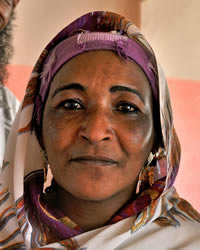Nubian, Dongola in Sudan

Photo Source:
Fabian Lambeck - Wikimedia
Creative Commons
|
Send Joshua Project a map of this people group.
|
| People Name: | Nubian, Dongola |
| Country: | Sudan |
| 10/40 Window: | Yes |
| Population: | 90,000 |
| World Population: | 90,000 |
| Primary Language: | Andaandi |
| Primary Religion: | Islam |
| Christian Adherents: | 0.03 % |
| Evangelicals: | 0.03 % |
| Scripture: | Portions |
| Ministry Resources: | No |
| Jesus Film: | Yes |
| Audio Recordings: | No |
| People Cluster: | Nubian |
| Affinity Bloc: | Sub-Saharan Peoples |
| Progress Level: |
|
Introduction / History
The Nubians consist of seven non-Arab Muslim tribes which originated in the Nubia region, an area between Aswan in southern Egypt and Dongola in northern Sudan. For centuries, this territory was a crossroads between Egypt and the African tribal kingdoms.
From the 1500s until the 1800s, the Ottoman Empire encroached upon the Nubia region. As a result, many Nubians migrated to remote areas along the Nile. Distinct groups evolved and were named according to their locations. For example, those who settled near the Wadi Kenuz became known as the Kenuzi while those who settled in Dongola became known as the Dongolawi or simply the Dongola Nubians.
In the 1960s, many of the Nubian villages were flooded as a result of the construction of the Aswan High Dam. About 100,000 Nubians were forced to resettle in "New Nubia," 20 miles north of Aswan. Others relocated in Uganda and Kenya. Most Nubian groups speak their own dialect of the Nubian language. For example, the Dongola speak Andaandi. However, many also speak Arabic which is the common language of business and trade. Although their languages are different, each group is identical in social, economic and cultural organization.
What Are Their Lives Like?
The Dongola Nubian economy is based on agriculture. During the winter months, they grow wheat, barley, millet, beans, peas, and watermelons. Mangoes, citrus fruits, and palm dates are also part of the Dongola Nubian diet. A thin, coarse bread called dura is one of their basic staple foods. Pieces of the bread are usually piled on top of each other and eaten with vegetables and sauces or are spread with date jelly.
In old Nubia, men migrated to the big cities to find work, while the women farmed the land, cared for the animals, and did household chores. Today, since the land is located far from their dwellings, men do most of the field work while the women work at the home. Some women have also found employment as schoolteachers, public service workers, and seamstresses. Some of the men now own grocery stores or drive cabs.
The typical Dongola Nubian house is very spacious, with several large rooms that are able to accommodate the extended family members and guests. In the center of each home is an open courtyard. The front of the house is colorfully painted with geometric patterns. Most of the paintings and decorations on the homes have religious connotations. The colorful designs are a distinctive and admired feature of Nubian culture.
The literacy rate among Dongola Nubians is high in comparison with their rural Egyptian neighbors. Primary and secondary schools have been set up in New Nubia, and there are also teacher-training facilities in the area. In addition to education, policies, radio and television are other ways in which socialization takes place among the Nubians.
For centuries, the Nubians often held lengthy religious and agricultural ceremonies. However, since relocation, the ceremonies have been shortened and are now limited to the villages. During these ceremonies, the Nubians express themselves through singing, dancing and beating drums.
What Are Their Beliefs?
The Nubians were converted to Christianity during the sixth century. They remained so until the gradual process of Islamization began taking place from the fourteenth until the seventeenth centuries. Today, the Nubians are almost all Muslims. However, their traditional animistic beliefs (belief that non-living objects have spirits) are still mingled with their Islamic practices.
The traditional beliefs of the Nubian peoples were centered on the spirit of the Nile. The Nile is believed to have life-sustaining power and to hold the power of life and death within it. The people believe that the river is endowed with angels, sheiks (religious leaders), and other powerful beings. The sheiks are sought daily for their advice in the areas of health, fertility, and marriage.
The Dongola Nubians have an annual festival known as the "Saints Day Celebration," or moulid. Gifts are presented at the ancestral shrines in the fulfillment of a promise made the previous year. They hold colorful processions during this time of celebration. Dancing, singing and feasting are part of the festivities. The moulid is still celebrated in New Nubia each year.
What Are Their Needs?
Most of the Nubian tribes have not heard a clear presentation of the gospel, and today there are probably no Christ followers among the Dongola Nubians.
Prayer Points
Pray that the Lord will raise up laborers who are willing to invest long term service as missionaries to the Dongola Nubians of Sudan.
Pray that loving African Christians will gain a vision to see the Nubians reached with the gospel.
Ask the Lord to save key leaders among the Dongola Nubians who will boldly declare the gospel.
Ask God to send medical teams and humanitarian aid workers to minister to the Dongola Nubians.
Pray that strong local fellowships of believers will be planted among each of the Nubian tribes.